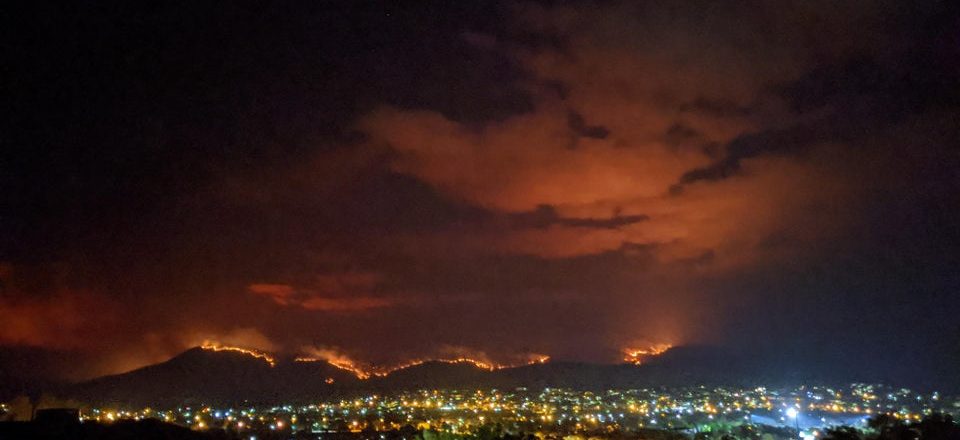
The sirens woke us at 4:45am. Two Rural Fire Service vehicles, lights flashing, made their way around the small campground on the New South Wales South Coast telling us to evacuate because of approaching fires. We hastily packed up our ash-covered site. The dawn never came. Instead, an eerie, deep dark red glow coloured the sky.
We got the kids in the car and drove out of the national park to Tathra. We spent an anxious day and New Years Eve night with family there who had already endured the devastating fires that destroyed almost 70 homes in the town in 2018.
We were lucky. Many others weren’t.
The next morning we got some of the last diesel in the area and drove home to Melbourne via smoke-choked Canberra.
I was in the Yarra Valley on Black Saturday in 2009. I helped set up Bushfire Legal Help (now Disaster Legal Help) that provides free legal help to Victorians affected by fires. But these latest fires feel different. These fires are different.
The threat has lasted for months and is still ongoing. The scale of the devastation is vast.
People in the bush are losing their lives, livelihoods and homes. While it pales in comparison, people in our cities are also being impacted with the smoke causing unprecedented air pollution. Health warnings. Pollution masks. Stinging eyes, coughing and asthma. Children being forced to stay inside. Events cancelled.
My hope is that these fires are a wake up call on the catastrophic human threat posed by climate change in Australia. That we see climate change as something immediate and concrete which affects people, not just our environment or economy.
UN High Commissioner for Human Rights, Michelle Bachelet, recently warned that the world has never seen a threat to human rights of this scope.
The evidence on the human threat posed by climate change is clear. The planet is getting hotter. Seas are rising. Rainfall patterns are changing. In Australia, our bushfire seasons are getting longer and more dangerous. The risk of other extreme weather events is also increasing.
Our human rights are already being affected and this will increase in severity. People will be displaced. Food production will be damaged. Extreme weather will take lives and homes. The poorest will be hit hardest and will have the least ability to cope.
If you live in Penrith in western Sydney and can’t afford an air conditioner you know all about the human impact of climate change. Penrith recently had its hottest day on record at 48.9 degrees. According to PwC, heatwaves kill more Australians than any other natural disasters, with the old, the young, pregnant and ill people at greater risk. This risk will worsen.
Globally, climate change will have severe impacts on health and poverty. Millions of people will be displaced creating climate refugees. The risk of armed conflict will rise. UN High Commissioner for Human Rights, Michelle Bachelet, recently warned that the world has never seen a threat to human rights of this scope.
The UN Expert on Extreme Poverty, Philip Alston, who happens to be an Australian, has reported on the risk of a ‘climate apartheid’ scenario where the wealthy pay to escape overheating, hunger, and conflict while the rest of the world is left to suffer.
People will be displaced. Food production will be damaged. Extreme weather will take lives and homes. The poorest will be hit hardest and will have the least ability to cope.
Successive Federal Coalition Governments have failed to respond properly to this threat. The Morrison Government must act faster to reduce Australia’s carbon emissions and transition to clean energy. Joining the dots between climate change and our human rights can help to spur action. International human rights law requires governments to take action to address the impact of climate change on people. It provides ways to raise awareness and pressure governments when they don’t.
While human rights advocacy and legal action on these issues is only just beginning, it will accelerate. The Australian Government is already facing its first UN human rights complaint over climate change. Brought by a group of Torres Strait Islander people, the complaint seeks faster cuts to emissions and measures including seawalls to protect their low lying islands in the north of Australia.
Climate change litigation is already being brought against governments and corporations in at least 28 countries including Australia. In December, the Dutch Supreme Court ruled that the Dutch Government had a legal obligation to increase emission cuts because of serious risks that climate change poses to the rights to life and wellbeing of the Dutch people. The decision relied heavily on the government’s legal obligations under the European Convention on Human Rights.
The Morrison Government must act faster to reduce Australia’s carbon emissions and transition to clean energy. Joining the dots between climate change and our human rights can help to spur action.
Australia is the only Western democracy without a national Charter of Human Rights and so Australians don’t have the same legal protections for our human rights. But there are still avenues to take legal action using environment, corporate and negligence laws that will increasingly be used.
The need to take urgent action on climate change is clear, for our environment, for our economy and for our human rights. The Australian Government’s current actions are not enough. If we want to save lives, livelihoods and homes, we must do more. Otherwise, what Australia has experienced over the past few months will become increasingly familiar.



